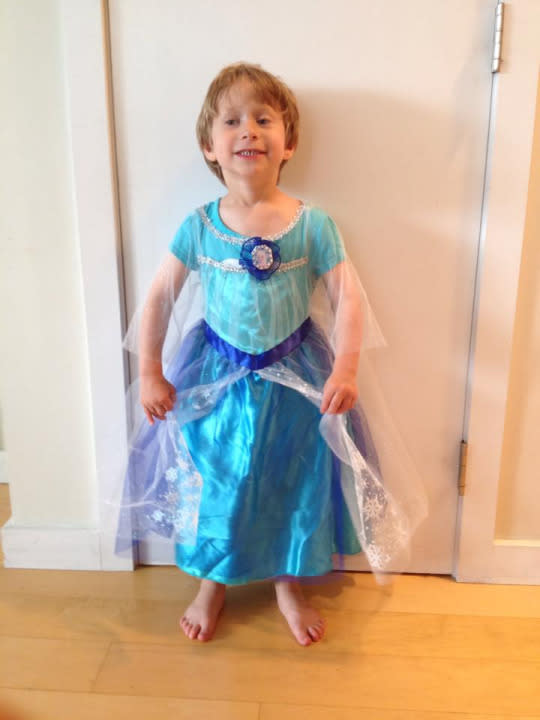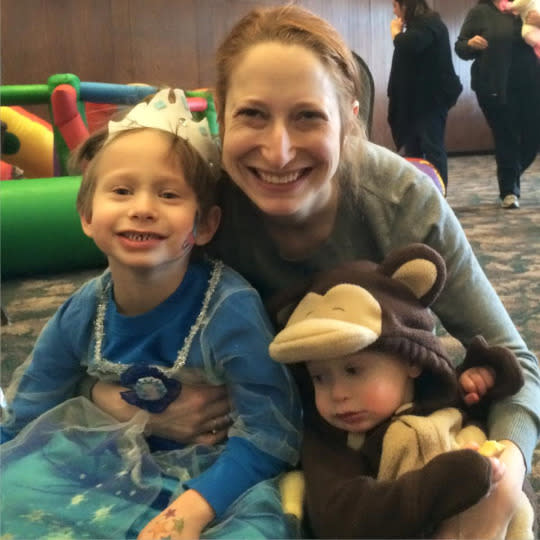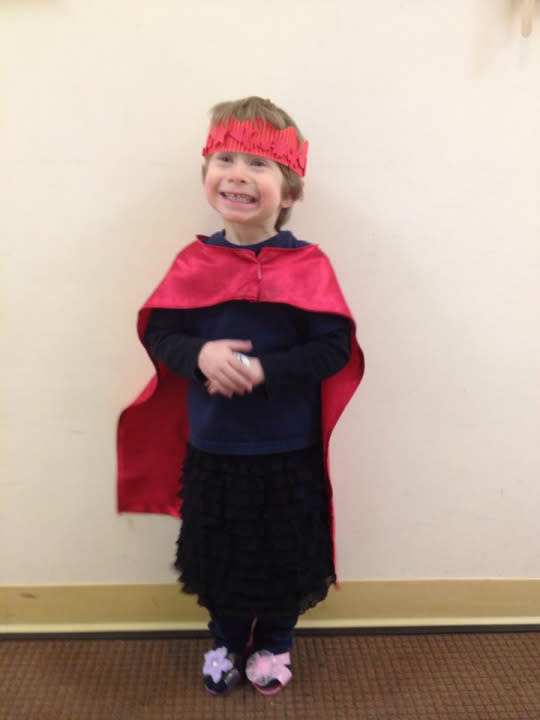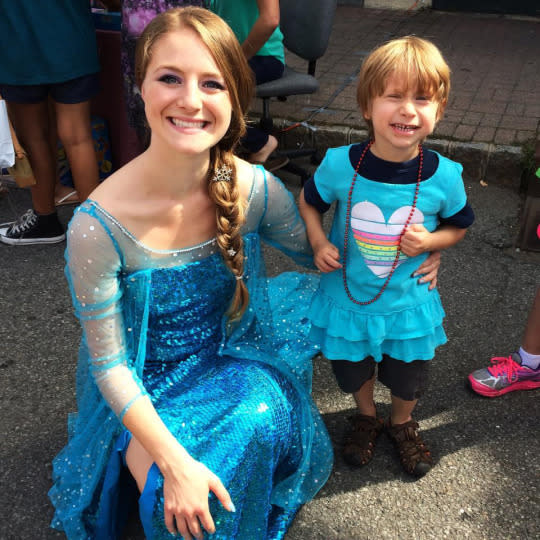Why I Post Pictures of My Son Wearing Dresses on Facebook

After Target stopped dividing its toy aisles by gender, Disney followed suit, announcing that it would no longer label costumes (including princess dresses) for girls or for boys. I hope this practice makes parents more comfortable buying non-gender-conforming items for their children. But my 5-year-old son didn’t care about labels or marketing when I bought him an Elsa dress last year.
As is mandatory for children in the post-2013 world, Noah loves Frozen. First, he was hooked by the songs. He sang along to the sweeping majesty of “Let It Go” on YouTube over and over until he memorized the lyrics.
STORY: Little Boy Dressed in Elsa Costume Goes Viral
The next step was to look like Elsa while singing it. Improvising, he grabbed a blanket, threw it over his shoulders, and declared it his cape. After I secured it with a binder clip, he was able to let go of the corners and continue with the appropriate grand gestures the song demanded. Soon, everything became a cape. Bubble wrap. My shirts. My husband’s pants. Anything and everything he could fling over his shoulders, he did.
STORY: The One Word Teachers Can Say to End Gender Stereotyping
Capes weren’t enough, though; he wanted a dress. I tried to get creative by wrapping one of my skirts around his chest, but even with two binder clips, it didn’t hold up to dancing. I needed a solution before Purim, the Jewish holiday where, as during Halloween, kids don costumes. And Noah was adamant — he, along with half the girls in his class, was going to be Elsa for his preschool Purim party.
My husband and I didn’t care that he wanted to dress up as his favorite character. After all, if we had a girl, we’d encourage her to follow her dreams, not matter how “un-girl-like;” why wouldn’t we do the same for a boy?

If a girl eschews dresses, dolls, and princesses, she’s a tomboy. What is a boy who likes more traditionally feminine things? A pansy? A fairy? A freak? Maybe we should come up with a new moniker for him. We cheer for girls in Darth Vader costumes; why not celebrate our boys in their princess wear?
Our low-budget, low-tech version of an Elsa costume included a handmade crown, a blue shirt, and a blue skirt (borrowed from his friend at the time). He proudly told his teachers and friends’ parents who he was. And in our accepting Brooklyn, N.Y., neighborhood, he inspired smiles — if anyone had anything negative to say, they didn’t say it to me.
After a while, Noah had enough of blankets and borrowed clothes — his dedication to his craft demanded a real Elsa dress. So one day while he was at school, I trekked to Target, and there, among Anna and Elsa dolls, tiaras, and wands, was The Dress. For $20, it could be mine. Well, Noah’s.
I admit; I paused. After all, it was one thing to allow my son to wear a friend’s clothes, but an actual princess dress? And one that I bought? What would it mean if I bought my son a dress? What would that show him? Pretty immediately, I shook off whatever doubt I had — I knew it would show him that I loved him and respected his choices and his passions.

He was a child. A nonsexual, imaginative, creative little person who wanted to express his love for a character by dressing like her. And there was nothing wrong with that. After all, what are the arguments against getting him a costume? That kids would make fun of him? He was the most sought-after boy in his class — the girls literally lined up to play “Princess” with him at school. That wearing a dress would make him feminine or gay? Do people still think that nonsense? If my kid wanted to wear a dress so badly that he’d trip over a blanket, I don’t think denying him some taffeta would sway who he found attractive. If he’s gay or transgender, then he is — playing dress-up won’t make him gay, and forbidding him to won’t make him straight.
Once it was purchased, I put the dress to work. In The Great Bribe Agreement of 2014, we made a deal with Noah, a perpetual early riser — if he stayed in his room until 6 a.m. for one week, he would earn the dress. It was the best $20 I ever spent.

Not only did I get to sleep in for a week, but Noah was incredibly proud of himself. He twirled around our apartment, basking in the joy of tulle, glitter, and determination.
Over the last five years, I’ve watched my son enjoy playing sports, wearing jewelry, drawing planets, clomping around in high heels, learning about dinosaurs, and dressing up like princesses. And I’ve photographed it all. I share the pictures because, like many people, I share my life on Facebook.
We don’t live in the world of gender nonconforming; we just visit it. My son identifies as a boy. Other than the few times he’s worn an Elsa costume (during holidays, and at an Elsa meet-and-greet), he wears “boy” clothing outside of the house. Although his sexuality can’t be confirmed at 5, he has always had girlfriends and has already chosen his four wives: Katy Perry, Taylor Swift, Rhianna, and me. But, like sexuality, gender and gender performance is a spectrum. Maybe by seeing our pictures, another parent will know that allowing their child to wear a costume doesn’t mean, well, anything other than they’re expressing themselves.
I love my son for who he is. He’s a boy who likes to wear an Elsa dress. And if the only thing he has to tell his therapist when he grows up is that I posted pictures of him wearing a costume, I’ll have done a pretty good job.
Please follow @YahooParenting on Facebook, Twitter, Instagram, and Pinterest. Have an interesting story to share about your family? Email us at YParenting (at) Yahoo.com.
